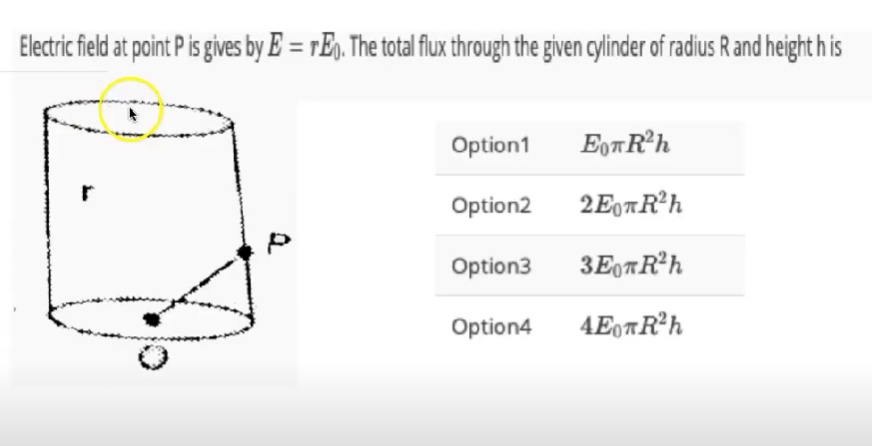Question
Question: Electric field at point P is given by $E=rE_0$. The total flux through the given cylinder of radius ...
Electric field at point P is given by E=rE0. The total flux through the given cylinder of radius R and height h is

E_0 \pi R^2 h
2 E_0 \pi R^2 h
3 E_0 \pi R^2 h
4 E_0 \pi R^2 h
2 E_0 \pi R^2 h
Solution
The electric field is given by E=rE0. Assuming this means the electric field is radial and its magnitude depends on the radial distance r from the central axis of the cylinder, we can write the electric field vector as E=E0rr^, where r^ is the radial unit vector.
To find the total flux through the cylinder, we can use Gauss's divergence theorem: Φ=∮SE⋅dA=∫V(∇⋅E)dV
First, we calculate the divergence of the electric field in cylindrical coordinates. For E=E0rr^, the components are Er=E0r, Eθ=0, and Ez=0. The divergence in cylindrical coordinates is: ∇⋅E=r1∂r∂(rEr)+r1∂θ∂Eθ+∂z∂Ez Substituting the components: ∇⋅E=r1∂r∂(r(E0r))+r1∂θ∂(0)+∂z∂(0)=r1∂r∂(E0r2)=r1(2E0r)=2E0 The divergence of the electric field is a constant, 2E0.
Now, we integrate the divergence over the volume of the cylinder. The volume of the cylinder of radius R and height h is V=πR2h. Φ=∫V(∇⋅E)dV=∫V(2E0)dV=2E0∫VdV Φ=2E0V=2E0(πR2h)
Alternatively, we can calculate the flux through each surface of the cylinder:
- Top surface: The area vector is dAtop=dAk^. Since E=E0rr^, E⋅dAtop=(E0rr^)⋅(dAk^)=0. So, Φtop=0.
- Bottom surface: The area vector is dAbottom=−dAk^. E⋅dAbottom=(E0rr^)⋅(−dAk^)=0. So, Φbottom=0.
- Curved lateral surface: The radius is r=R. The area vector is dAlateral=Rdθdzr^. The electric field on this surface is E=E0Rr^. E⋅dAlateral=(E0Rr^)⋅(Rdθdzr^)=E0R2dθdz Integrating over the curved surface: Φlateral=∫z=0h∫θ=02πE0R2dθdz=E0R2∫0hdz∫02πdθ=E0R2(h)(2π)=2πR2hE0 The total flux is the sum of fluxes through all surfaces: Φtotal=Φtop+Φbottom+Φlateral=0+0+2πR2hE0=2E0πR2h.
Both methods yield the same result.
